A variegated string of pearls is not the usual succulent plant that you already know. In the wild, this charming plant can be seen crawling on the ground under the shades of tall trees.
This is because it can easily grow new roots once it touches the soil. Whether you prefer this indoor or outdoor, you are very likely to succeed.
How to propagate a variegated string of pearls plant? Stem cutting is the ideal way of propagating a variegated string of pearls. Seed planting is usually less successful since not all seeds are viable. Spring and summer are the best seasons to propagate this plant, and in the early fall in warmer climates.
Also known as “Senecio Rowleyanus Variegata,” a variegated string of pearls is a succulent vine famous for its unusual appearance. This trailing beauty is not difficult to grow and requires minimum maintenance.
If you are interested in adding them as your house plant, this comprehensive guide can surely help you.
What Do Variegated String of Pearls Plant Look Like?
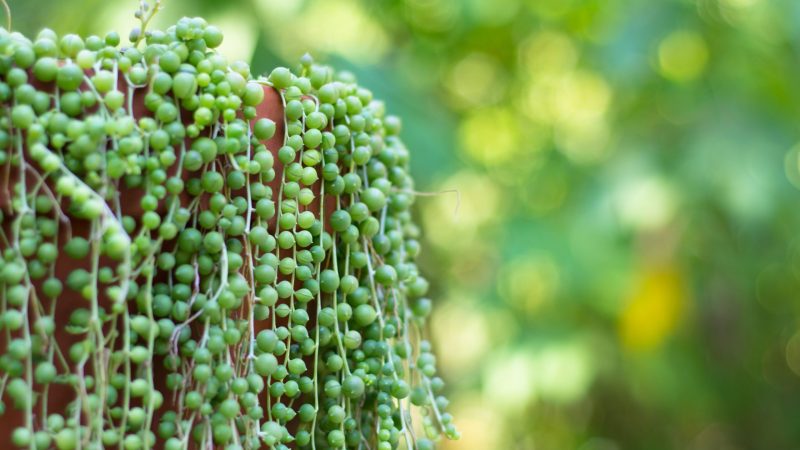
The leaves of a variegated string of pearls plant look like tiny pearls, which grow on slender stems, hence the name. This type of string of pearls produces white flowers, along with green stems with at least three white and green leaves.
Also, this succulent plant is very unique and looks very beautiful in a hanging basket.
Is String of Pearls Toxic?
The string of pearls (other names are the string of beads and rosary) is toxic to both humans and pets but only minor and not life-threatening. According to the University of California, Davis, the toxicity of string of pearls is under classes 2 and 4.
Class 2 means that accidental swallowing of this plant can lead to minor illnesses such as diarrhea or excessive vomiting.
On the other hand, Class 4 means that any person or animal that made direct contact with the juice or sap of string of pearls may encounter skin irritation or rashes, especially in the mouth.
If you believe that your child or pet has ingested this plant, contact your pediatrician or veterinarian immediately.
Is Variegated String of Pearls Rare?
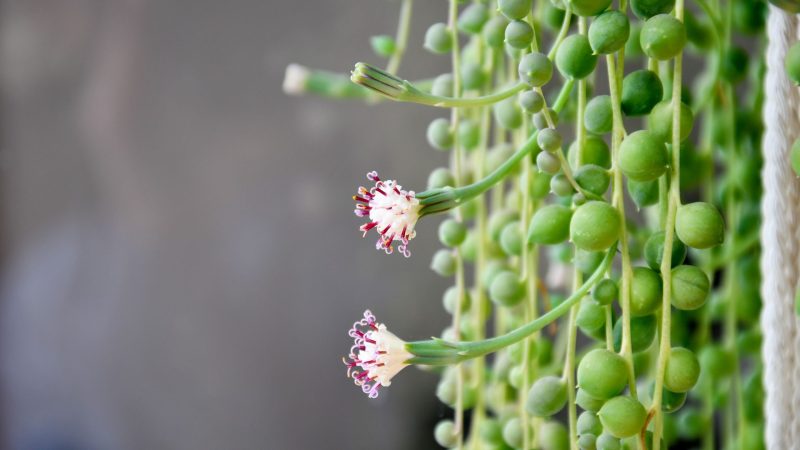
A variegated string of pearls is rare. In fact, it is very rare that Succulents Box is the only known huge plant store in the United States that grows this type of string of pearls.
But don’t worry; you can still find lots of plant enthusiasts and small plant nurseries selling them online. They are also very affordable.
How Fast Does String of Pearls Grow?
With proper care, a string of pearls plants grow between 5 and 15 inches per year but can be less if you don’t propagate them.
On average, a single plant can survive for about 5 years but it can live continuously if you propagate them from stem cuttings. Repotting only when necessary can help in extending its lifespan.
Propagating Variegated String of Pearls | A Step by Step Guide
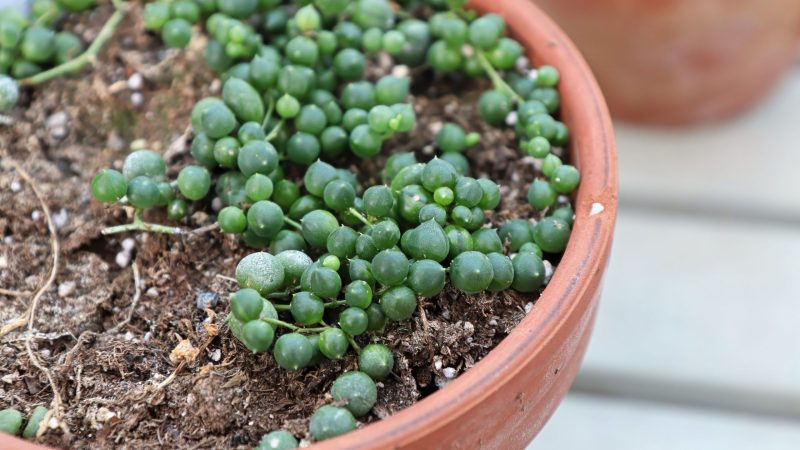
Propagating variegated string of pearls through stem cutting is not as hard as you think. Here is a step-by-step guide that is very easy to follow:
Step 1: Get a pair of sterilized pruning snips or scissors, a 4 to 6-inch pot, and a well-draining potting soil mix.
Step 2: Cut several 4 – 5 inches in length stems (with healthy pearls) just below a leaf node from your existing variegated string of pearls.
Step 3: Remove the two bottom leaves from the trimmed stems so that they will stick better in the soil.
Step 4: Watering is not necessary because the pearls already have enough water and nutrients for them to grow.
Step 5: For better drainage, place some kitchen paper at the bottom of the pot before putting the cut ends on top.
Step 6: Lay the cutting on the pot to allow it to dry before planting them.
Step 7: After 2 – 3 days, the callus will develop and you will start to see some roots. In some cases, roots will appear within a week.
Step 8: Fill the pot with potting soil mix and make a small hole at the center.
Step 9: Place the rooting stems at least one inch deep into the hole. Be careful not to damage the roots.
Step 10: Place the pot under bright, indirect sunlight and water the plant thoroughly but very lightly.
Another way of propagating variegated string of pearls is by laying the stem cuttings flat on the soil and sticking the roots into the soil, instead of planting them into the soil.
Alternatively, place the cuttings in a jar with clean water until new roots are growing. After about a month, transfer it to a pot with a potting mix.
How Do You Care For Variegated String of Pearls?
Despite being unique and rare, a string of pearls does not need special care. In fact, this succulent vine does not require frequent watering. Nevertheless, here are some useful tips on how to care for string of pearls, indoors and outdoors:
- Never place your string of pearls under direct sunlight, especially during summer. Use medium light only for indoors and shaded sunlight for outdoors.
- For indoor plants, the temperature should be 70 – 80°F (21 – 26.6°C).
- During winter, the temperature should be 55 – 60°F (12.7 – 15.5°C).
- Relative humidity should be 40 – 50% and less than 40% in the winter. Note that these are the standard humidity levels in households.
- Use light, well-draining potting mix. If possible, add some perlites.
- The string of pearls is very sensitive to overwatering. Use the “soak and dry” watering method.
- Avoid using pots that are too large for the plant, unless you need to repot it once it becomes too big for the existing pot.
- In general, fertilizing string of pearls is not necessary, especially during fall and winter. Fertilization is usually done during the growing season, which is between spring and summer.
- Use a balanced fertilizer solution and feed the soil once or twice a month. To avoid leaf damage, spray very gently and don’t use a stream.
How and When to Repot String of Pearls?
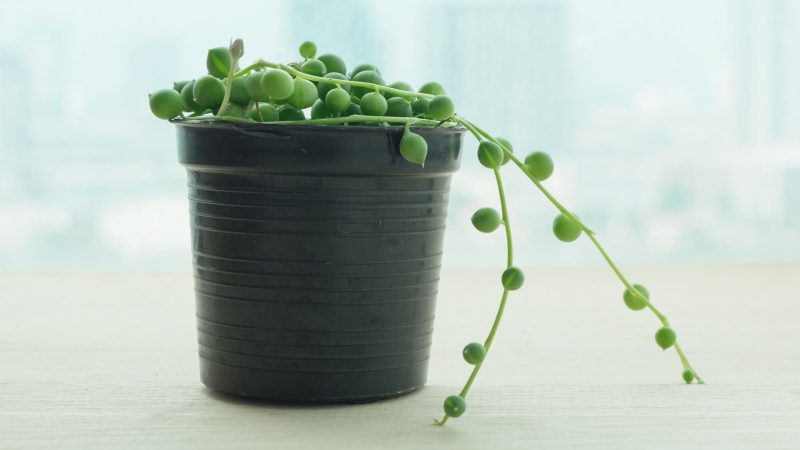
Repotting a string of pearls is not done unless necessary. You should repot your plant only if it has overgrown its pot, if your plant is dying, or if you will propagate a new plant.
Ideally, repotting is done in the early spring and summer (from March to August), especially if your plant is already growing actively.
The steps in repotting a string of pearls are similar to propagating the plant but you don’t need to cut the stems unless they are dying. If the plant is in a hanging basket, remove the clips and hooks to avoid damaging the plant.
To minimize the repotting frequency, use a pot about 10% bigger and higher than the existing pot.
How and When to Prune String of Pearls?
Pruning of string of pearls is done if you only need to cut the damaged or dead leaves, or stems that have been losing some leaves. You can also cut some stems if you will propagate new plants from them.
Sterilize your scissors or knife before using them. Other than these instances, pruning is not necessary.
Can String of Pearls Grow Indoors?
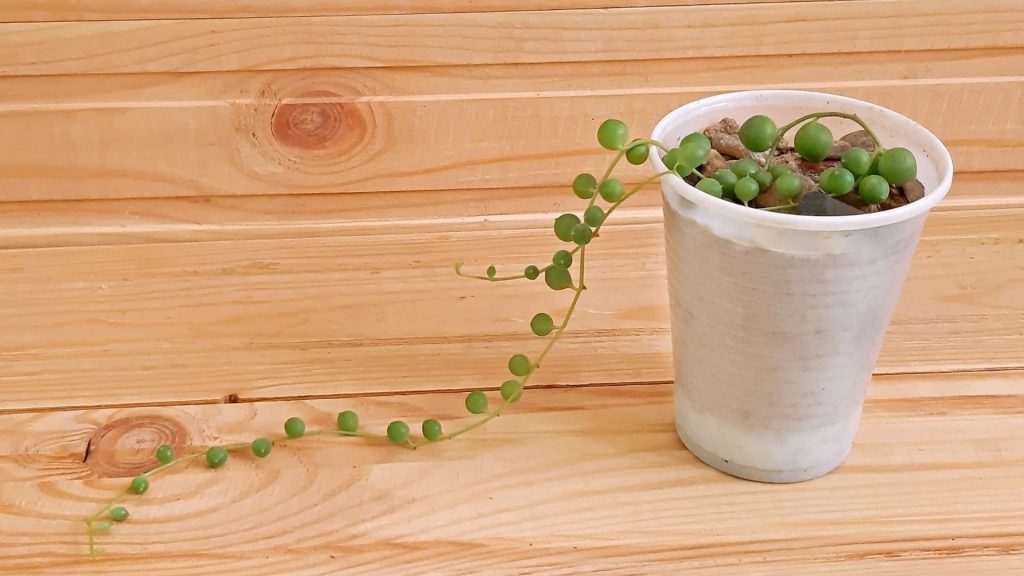
The string of pearls can grow indoors. As a matter of fact, this delicate succulent plant is mostly indoors, especially in the winter. Despite being toxic, you can place it in your living room and bathroom.
However, it’s best if you place it in a hanging basket high enough so that your pets and small children cannot reach it.
Why Are My String of Pearls Turning Purple?
Once your string of pearls is starting to turn purple, it’s a sign that your plant is under stress. In some cases, it can turn orange or blue.
The color change is due to various environmental factors, including overwatering, underwatering, excessive heat, lack of light, heavy soil, overfertilization, pests, and diseases.
How Do You Know When a String of Pearls Is Dying?
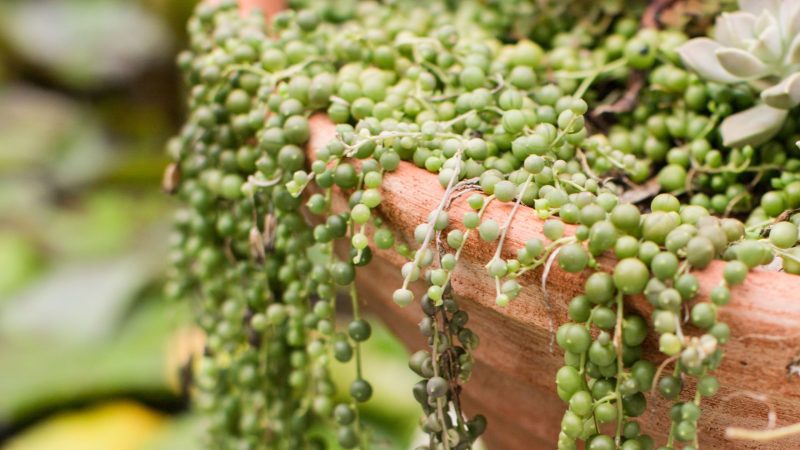
As mentioned above, a string of pearls is very easy to manage but they can still feel stress. They may eventually die if you do not take the necessary actions immediately.
Below are some symptoms of a dying string of pearls plant, their causes, and how you can still possibly save them:
1. Shriveling Pearls
If your string of pearls is shriveling or is getting wrinkled, the most possible cause is overwatering. In fact, it is the most common reason why this plant stops growing.
Excessive water can burst the pearls, causing them to die. Therefore, water the plant thoroughly and wait for the water to drain before watering it again.
On the other hand, shriveling can also be due to underwatering. Aside from shriveling, the leaves will also dry out if there is not enough moisture. To avoid this, water your plant once the soil starts to become dry but not totally dry.
In some cases, the leaves will also turn violet or brown if watering is not sufficient.
2. Leaves Changing Colors
Aside from turning violet, the leaves of a string of pearls can also turn yellow and will fall off due to underwatering. This change of colors can also be because of low light, overwatering, overfertilization, and cold temperatures.
Brown leaves may also be caused by external damage during the relocation of the plant.
Meanwhile, overfertilization of string of pearls and a pest infestation can also lead to having yellow leaves. Note that this succulent plant does not need too much fertilizer, as compared to other plants.
You must not water your plant if the soil surface is still wet. If necessary, trim or cut the yellow leaves.
3. Sunburn or Burnt Leaves
Sunburn, scorched or burnt leaves are due to excessive light, which usually happens if your string of pearls is outdoors, especially during hotter months.
Nonetheless, it can also happen to indoor plants if they are placed close to the window in the summer. Remember, direct sunlight can kill your string of pearls.
As a countermeasure, hang your string of pearls from a tree or porch to reduce the amount of heat it will receive from the sun. For indoor plants, don’t put your plants on windows if direct sunlight is coming through them.
In some cases, prolonged exposure to direct sunlight can also cause the leaves to turn brown.
4. Untidy and Uneven Growth
If your string of pearls looks untidy and is growing unevenly, there’s a huge chance that it is not receiving enough light. Also, if your plant lacks light and receives too much water, it may soon die.
To avoid this, move your plant to an area with higher light intensity and water it if the soil surface is completely dry.
Ideally, the string of pearls plants should receive bright light for 6 – 8 hours a day. If your window is facing the south, place your plant a few feet away from the windows.
But for north-facing windows, you can move your plant a bit closer to it. For outdoor plants, move them to brighter areas or under indirect sunlight.
5. Leaves Have Holes or Marks
If the leaves of your string of pearls have holes or marks, it’s very likely due to pest infestation. Other signs that your plants are being infested by pests are having yellow or sticky leaves.
The stickiness of the leaves is caused by the residue that the unwanted insects have left behind after sucking the sap out.
Among the common pests of the string of pearls are aphids, ants, spider mites, gnats, and mealybugs. These annoying pests feed on the juices of your plants, causing holes in their leaves.
Since most of these pests reside from the undersides of the leaves, spray soapy water or plain water on them repeatedly.
6. Soil Stays Wet Too Long
Typically, water should drain within a few minutes after watering your string of pearls. If the soil stays wet longer than usual, it can cause root rot because air is not circulating properly.
Among the possible reasons for the slow drainage includes high humidity, heavy soil, wrong soil mix, or if the pot is too large for the plant.
If the soil has a foul smell, carefully take your string of pearls out of the pot, wash the roots to remove the soil, and repot your plant. Cut the dying leaves, if there are any.
If your soil is too heavy for your plant, replace it with fresh, lighter soil and add some perlite for proper drainage. Try using a cactus potting mix.
Does Variegated String of Pearls Revert?
A variegated string of pearls can revert or return to its original green color. This phenomenon occurs due to a lot of factors including extreme changes in hot and cold temperatures, insufficient light, and the plant’s technique to survive.
If a variegated plant is not getting enough light, it will force its leaves to turn green.
Can Reverted Variegation Come Back?
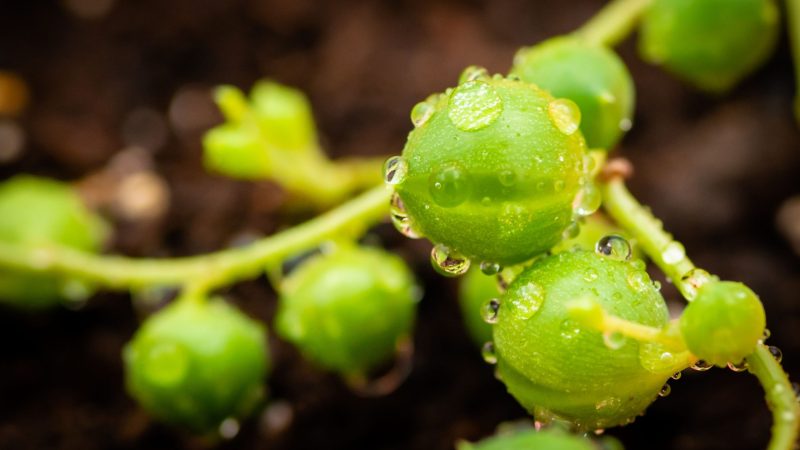
Unfortunately, reverted variegation can no longer come back being variegated. It means that once a variegated plant has already green leaves, it will remain that way.
They need to make more chlorophyll to produce green leaves so they can survive. Therefore, it is not possible for them to have variegated colors again.
How Much Are Variegated String of Pearls?
The price of a variegated string of pearls depends on the size of the pot, as well as the height and spread of the plant.
Currently, a 2-inch pot of variegated string of pearls can be as low as $7.99 only, while a 3.5 – 4-inch pot can cost between $15 and $20. The shipping fee depends on your location and where it will come from.
Here is a video about the variegated string of pearls’ price and some tips for repotting:
Summary
A variegated string of pearls is also good for beginners, as long as the above tips are followed. Propagation can be done repeatedly, and you don’t need to buy a new one to have a new plant.
Interestingly, this low-maintenance plant can also be a wonderful gift to your friends and relatives on any kind of occasion.
Related: Succulent Pots and Succulent Planters | A Complete Guide
List of Sources
Safe and Poisonous Garden Plants
Different Types of Succulents and Cactus and Care and Growing Tips